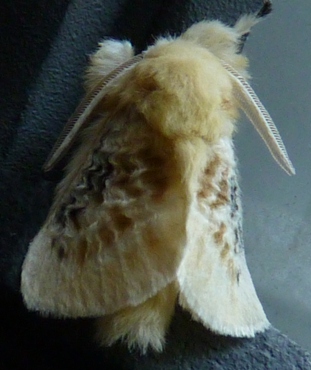Daily Times: Conservation is Insurance for the Future
 Monday, November 28, 2011
Monday, November 28, 2011
By ANDY PITZ and ROGER LATHAM
Times Guest Columnists
Have you ever heard of the puss caterpillar? Chances are that unless you’re from the South, the answer is no.
But that could soon change as discoveries of this deceptively poisonous insect are becoming increasingly common in New Jersey and Pennsylvania.

Puss Moth
While the puss caterpillar is alarming in its own right — touching its barbs can cause intense pain, headaches, nausea, vomiting, and sometimes death — its migration is a sure sign of the greater effects of global warming.
In fact, scientists recently released a study finding that animals and plants are moving away from the equator to escape rising temperatures more rapidly than expected. As this happens, new arrivals will interact with existing species in our region in new and unpredictable ways. Existing species may be pushed out, afflicted by new parasites, or have to compete with a host of new invasive plants, insects, and animals. These migrations are just one example of how climate change is impacting the Delaware Valley.
As we have seen in the flooding associated with Hurricane Irene and Tropical Storm Lee and with the power outages that accompanied the Halloween weekend snowstorm, our region is not immune to extreme weather events. With increasing frequency, our region is left to grapple with the aftermath. Homes and property are destroyed by flooding. Crops are lost because of either too much rain or not enough. Businesses suffer.
Other changes are more subtle, but are sure signs that our planet is getting warmer.
At Natural Lands Trust’s Glades Wildlife Refuge along the Delaware Bay in Southern New Jersey, for instance, rising sea levels are causing saltwater intrusion into forested areas where many tree species not adapted to higher alkalinity are dying in startling numbers. Higher sea levels also threaten vast expanses of salt marsh that are a major nursery for fish and other sea life. While the marshes may be able to migrate inland to some extent, they will do so at the expense of forests and farmlands. And, because of topography along the coast, the majority of the marsh will not be replaced.
Though it is true that species migrations and periods of death and regrowth have been seen throughout the Earth’s history, the increasing speed at which they are now occurring is cause for concern. We may find that neither we nor our ecosystems will be able to keep up. This could result in the extinction of a range of plants and animals that we depend on for our survival.
This is why the work of land conservation is so important. As the region’s largest land conservation organization, Natural Lands Trust owns and manages 40 nature preserves totaling more than 21,000 acres and holds conservation easements and other land restrictions exceeding 19,000 acres. By protecting and stewarding the land, we help to build resilient ecosystems that can sustain — and in some cases help combat — the effects of global warming.
How forests are managed once they are protected, however, is just as important to their preservation and resilience. Natural Lands Trust is working to create and support healthy forests by controlling invasive species and by planting trees that can stand up to extreme weather conditions such as droughts, extreme heat, and saturating rains.
The organization is doing the same with grasslands and meadows. By managing these lands and planting species that can survive harsh conditions, we are better able to protect our ecosystems and prevent the extinction of wildlife and plant habitat.
Though addressing climate change is not Natural Lands Trust’s primary mission, preserving forests, restoring wetlands, and protecting grasslands — the things the organization does day in and day out — are helping to mitigate the real and present consequences of a warming planet.
This work is a kind of insurance: An up-front investment that will protect us against potentially devastating climate changes in the future by making our lands stronger, richer, and more resilient.
Andy Pitz is vice president of strategic policy and planning at Natural Lands Trust. Roger Latham is a conservation biologist and member of Natural Lands Trust’s Board of Trustees.
